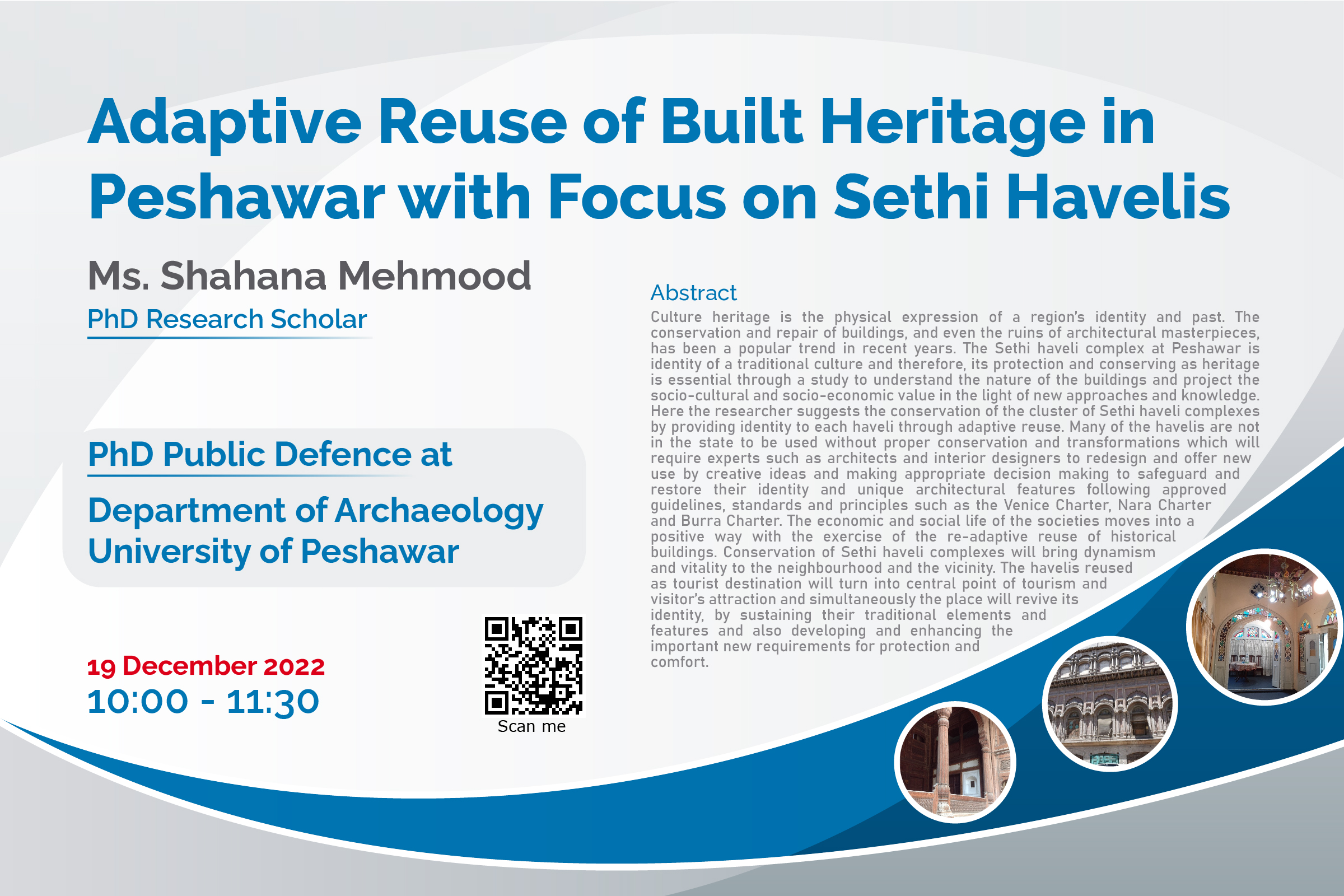PhD Public Defence of Ms. Shahana Mehmood (research scholar Archaeology)
Adaptive Reuse of Built Heritage in Peshawar with Focus on Sethi Havelis
Shahana Mehmood (PhD Research Scholar, Archaeology)
Abstract
Culture heritage is the physical ex
The dissertation is focused on the Sethi haveli complexes which fulfilled not only the requirements of the residence but they also cater to the Sethis commercial and social needs by constructing the required structures either inside the haveli or adjacent to the family portion according to their financial strength. The havelis are built during 1800-1910 AD. The Sethis came from Bhera to Chamkani and then to the city in Peshawar and from normal merchants, they became a business community.
The haveli architecture is a combination of many cultures, with taste of central Asian, Colonial and local traditions. The haveli are constructed in a very flexible vernacular type with providing privacy to the inhabitants but simultaneously it had capacity to absorb the changing trends of culture in the late 19th century and easily adapted new uses with the old functions. The haveli adapted new styles in their exterior elevations and facades while making it more stylish and fashionable by incorporating fresco work, stucco work, woodwork, naqqashi, mirror-work, Shah-Jahani columns, stained glass, gothic style in windows and doors, fanlights, bay windows, balconies lined with wrought iron grilles. These haveli complexes were originally built for multiple uses, planned around a square courtyard with arcaded rooms (arcaded spaces), divided into domestic quarters (zenan-khana), guest house (mehman-khana) and offices (daftar-khanay).
Majority of the Sethi haveli complexes are presently used for domestic and other purposes. Those buildings which are occupied are for certain extent in better condition than those that are lying vacant since years. Few old haveli are in deteriorating conditions. The windows, the glass panes and doors are broken, floors are cracked and there are shear cracks.
Adapting historic structures to new uses for the sake of tourism promotion, have not been thought of as the functions given to these havelis. Adaptive reuse of Sethi haveli complexes, if undertaken appropriately, will benefit many sectors of this place. Visitors' decisions about where to travel, are influenced by a variety of factors, including the beauty or popularity of a tourist destination, which is made up of a variety of multidimensional characteristics including establishing facilities and services that accommodate site visitors' requirements and aspirations. Setting a pleasant atmosphere in place would entice customers to visit this heritage landmark, which may serve as an important economic approach for conserving and use adaptive cultural resources for the long term.
An appropriate adaptive reuse of the Sethi haveli complexes will avert deterioration by restoring and continuous upkeep. This will bring awareness and will grab attention of the government and all those who are interested in culture heritage to readapt and reuse all kind of such valuable buildings to promote tourism and generate income for the people in this city. After reviving these buildings and when preserved skilfully will bring back its glory which will not only enhance interest of the locals but people from other areas as well. It will give identity to the local community and to the Sethi muhallah itself.
To attract cultural tourists from near and far, the initial adaptive reuse plans shall be to concentrate on attracting a great number of tourists to the area, by developing tourists experience and perception of the Sethi muhallah. The author has proposed the adaptive reuses as folk museum, art and craft galleries, entertainments centres, Sethi house museum, vocational schools (photography, textiles), library, tea rooms, vintage music library, hotels, guest rooms, shops with traditional commodity and an open-air roof top restaurants which will be led by the historic Sethi Bridge (chatti gali) that is the most attractive feature of Sethi muhallah.
Providing the result, impact, and sustainability of programmes has become a need for obtaining more financing and support for cultural policy. In the process of adaptive reuse of Sethi haveli complexes the expenses and budgets for cultural initiatives may be determined because estimating the benefits is more challenging.
To get genuine viewpoints regarding the current culture-led regeneration activities, this thesis picked target location that is in decline and needs urban redevelopment programs. More diversified places for example, the interior wall city of Peshawar that has not been designated as a priority area for adaptive reuse, might deliver additional compelling findings to cultural events and regeneration initiatives in the future, expanding the socio-cultural and economic regeneration study through cultural events.

